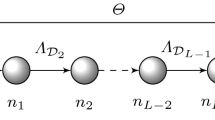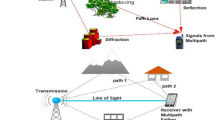Abstract
The dynamic estimation algorithm for Rician fading channels in GSM-R networks is proposed, which is an expansion of local mean power estimation of Rayleigh fading channels. The proper length of statistical interval and required number of averaging samples are determined which are adaptive to different propagation environments. It takes advantage of signal samples and Rician fading parameters of last estimation to reduce measurement overhead. The performance of this method was evaluated by measurement experiments along Beijing–Shanghai high-speed railway. When it is NLOS propagation, the required sampling intervals can be increased from \(1.1{\lambda}\) in Lee’s method to \(3.7{\lambda}\) of the dynamic algorithm. The sampling intervals can be set up to \(12{\lambda}\) although the length of statistical intervals decrease when there is LOS signal, which can reduce the measurement overhead significantly. The algorithm can be applied in coverage assessment with lower measurement overhead, and in dynamic and adaptive allocation of wireless resource.












Similar content being viewed by others
References
Aja-Fernández, S., Niethammer, M., Kubicki, M., Shenton, M., & Westin, C. (2008). Restoration of DWI data using a Rician LMMSE estimator. IEEE Transactions on Medical Imaging, 27(10), 1389–1403.
Akhoondzadeh-Asl, L. & Noori, N. (2007). Modification and tuning of the universal Okumura-Hata model for radio wave propagation predictions. In Asia-Pacific Microwave Conference, pp. 1 –4 (2007).
Andersen, J., Rappaport, T., & Yoshida, S. (1995). Propagation measurements and models for wireless communications channels. Communications Magazine, IEEE, 33(1), 42–49.
Austin, M. & Stuber, & G. (1994). Velocity adaptive handoff algorithms for microcellular systems. IEEE Transactions on Vehicular Technology, 43(3), 549–561.
Baldini, G., Nai Fovino, I., Masera, M., Luise, M., Pellegrini, V., Bagagli, E., et al. (2010). An early warning system for detecting GSM-R wireless interference in the high-speed railway infrastructure. International Journal of Critical Infrastructure Protection, 3, 140–156.
Bjornson, E. & Ottersten, B. (2010). A framework for training-based estimation in arbitrarily correlated Rician MIMO channels with Rician disturbance. IEEE Transactions on Signal Processing, 58(3), 1807 –1820.
De la Vega, D., Lopez, S., Gil, U., Matias, J., Guerra, D., Angueira, P., & Ordiales, J. (2008). Evaluation of the Lee method for the analysis of long-term and short-term variations in the digital broadcasting services in the MW band. Proceedings of the IEEE International Symposium on Broadband Multimedia Systems and Broadcasting, 2008 (pp. 1–8).
De la Vega, D., Lopez, S., Matias, J., Gil, U., Pena, I., Velez, M., Ordiales, J., & Angueira, P. (2009). Generalization of the Lee method for the analysis of the signal variability. IEEE Transactions on Vehicular Technology, 58(2), 506 –516.
Flammini, F., Gaglione, A., Mazzocca, N., & Pragliola, C. (2009). Quantitative security risk assessment and management for railway transportation infrastructures. Critical Information Infrastructure Security, pp. 180–189.
Goldsmith, A., Greenstein, L., & Foschini, G. (1994). Error statistics of real-time power measurements in cellular channels with multipath and shadowing. IEEE Transactions on Vehicular Technology, 43(3), 439–446.
Gopal, L., Singh, A., & Shanmugam, V. (2009). Power estimation in mobile communication systems. Computer and Information Science, 1(3), P88.
Gudmundson, M. (1991). Correlation model for shadow fading in mobile radio systems. Electronics letters, 27(23), 2145–2146.
Hata, M. (1980). Empirical formula for propagation loss in land mobile radio services. IEEE Transactions on Vehicular Technology, 29(3), 317–325.
Itoh, K., Watanabe, S., Shih, J., & Sato, T. (2002). Performance of handoff algorithm based on distance and RSSI measurements. IEEE Transactions on Vehicular Technology, 51(6), 1460–1468.
Lee, W. (1985). Estimate of local average power of a mobile radio signal. IEEE Transactions on Vehicular Technology, 34(1), 22–27.
Marzetta, T. (1995). EM algorithm for estimating the parameters of a multivariate complex Rician density for polarimetric SAR. Proceedings of the International Conference on Acoustics, Speech, and Signal Processing, 1995, vol. 5 (pp. 3651–3654). IEEE.
Medeisis, A. & Kajackas, A. (2000). On the use of the universal Okumura-Hata propagation prediction model in rural areas. IEEE 51st Vehicular Technology Conference Proceedings, 2000, vol. 3 (pp. 1815–1818). IEEE.
Mousa, A. & Mahmoud, H. (2010). Channels estimation in OFDM system over Rician fading channel based on comb-type pilots arrangement. Signal Processing, IET, 4(5), 598–602.
Ostlin, E., Suzuki, H., & Zepernick, H. J. (2008). Evaluation of the propagation model recommendation ITU-R P.1546 for mobile services in rural Australia. IEEE Transactions on Vehicular Technology, 57(1), 38–51.
Prieto, G., Guerra, D., Matias, J. M., Vlez, M., & Arrinda, A. (2008). Digital-radio-mondiale (drm) measurement-system design and measurement methodology for fixed and mobile reception. IEEE Transactions Instrumentation and Measurement, 57(3), 565–570.
Saleh, A. & Valenzuela, R. (1987). A statistical model for indoor multipath propagation. IEEE Journal on Selected Areas in Communications, 5(2), 128–137.
Sarkar, T., Ji, Z., Kim, K., Medouri, A., & Salazar-Palma, M. (2003). A survey of various propagation models for mobile communication. Antennas and Propagation Magazine, IEEE, 45(3), 51–82.
Shafiullah, G., Gyasi-Agyei, A., Wolfs, P. (2007). Survey of wireless communications applications in the railway industry. Proceeding of the 2nd International Conference on Wireless Broadband and Ultra Wideband Communications, 2007 (p. 65).
Sijbers, J., Den Dekker, A., Scheunders, P., & Van Dyck, D. (1998). Maximum-likelihood estimation of Rician distribution parameters. IEEE Transactions on Medical Imaging, 17(3), 357–361.
Tepedelenlioğlu, C., Abdi, A., Giannakis, G., & Kaveh, M. (2001). Estimation of Doppler spread and signal strength in mobile communications with applications to handoff and adaptive transmission. Wireless Communications and Mobile Computing, 1(2), 221–242.
Wubben, D., Seethaler, D., Jaldén, J., & Matz, G. (2011). Lattice reduction – A survey with applications in wireless communications. Signal Processing Magazine, IEEE, 28(3), 70–91.
Zhang, N. & Holtzman, J. (1996). Analysis of handoff algorithms using both absolute and relative measurements. IEEE Transactions on Vehicular Technology, 45(1), 174–179.
Zhu, H., Yang, Q., & Kwak, K. (2005). Performance analysis of fast handoff with mobility prediction. Proceedings of the IEEE International Symposium on Communications and Information Technology, vol. 1 (pp. 75–78). IEEE.
Acknowledgments
The research was supported in part by Key Project of Ministry of Railway (2010X020), NSFC (No. 61172064, 61104091), Specialized Program for New Century Excellent Talents in University (No. NCET-11-0326), Research Fund for Doctoral Program of Higher Education (No. 20100073120061), SJTU Science and Technology Innovation Funding (No. AE0300006), HKUST (No. RPC11EG29, SRFI11EG17-C and SBI09/10.EG01-C), NSFC/RGC (No. N-HKUST610/11), Huawei Technologies Co. Ltd. (No. HUAW18-15L0181011/PN), China Cache Int. Corp. (No. CCNT12EG01), and Guangdong Bureau of Science and Technology (No. GDST11EG06).
Author information
Authors and Affiliations
Corresponding author
Appendix Proof of Theorem 1 and 2
Appendix Proof of Theorem 1 and 2
1.1 Proof of Theorem 1
The normlving the integral formualized estimation error P e can be determined by \(\hat{s}\) and \(\sigma_{\hat{s}}\) according to Definition 1, and \(\sigma_{\hat{s}}\) can be calculated by
where R 2 p_r (τ) = E[p 2 r (x)p 2 r (x + τ)] − E[p 2 r (x)]E[p 2 r (x + τ)] is the autocovariance function of the squared envelope of p r (x). R 2 p_r (τ) can be derived from Rician distribution (Eqs. 6, 7 in Sect. 2) by approximation [4] as follows:
where \(J_0(\cdot)\) is the zero-order Bessel function, and \(\eta=\cos\theta_0\) is the intermediate valuable. Then \(\sigma_{\hat{s}}^2\) can be calculated by substituting (23) into (22), i.e.,
where ρ = τ/λ is the intermediate valuable and \(\sigma_{\hat{s}}^2\rightarrow0\) as \(2L/\lambda\rightarrow\infty\). \(\hat{s}\) can be considered as Gaussian distributed when 2L is large enough. Then \(\sigma_{\hat{s}}^2\) can be represented by the simple form as follows:
where n: = 2L/λ represents the relationship between statistical intervals 2L and wireless prorogation wavelength \(\lambda, g(K;\rho):=[J_0^2(2\pi \rho)+2KJ_0(2\pi \rho)\cos(2\pi \eta)]\rho\) is the intermediate function.
Given the definition of normalized estimation error P e in (12), it can be calculated by substituting (25) into (12) and solving the integral formula. Then P e can be determined by
1.2 Proof of Theorem 2
According to the characteristics of Rician distribution, it can be expressed that z 2 i = x 2 i + y 2 i where \(x_i \sim N(\nu\cos \eta,\sigma^2)\) and \(y_i \sim N(\nu\sin \eta,\sigma^2)\) are statistically independent normal random variables and η is any real number. Let x 0i = x i /σ, then \(x_{0i} \sim N(\nu \sin \eta,1)\) and its sum subject to the non-central χ2 distribution, that is \(\sum\nolimits_{i=1}^{N}x_{0i}^2 \sim \chi_N^2(\nu^2\cos^2\eta)\). For E[χ 2 n (λ)] = n + λ and D[χ 2 n (λ)] = 2n + 4λ, the mean value and variance of \(\sum\nolimits_{i=1}^{N}x_{i}^2\) can be calculated by:
and \(E\left[\sum_{i=1}^{N}y_i^2\right]=\sigma^2(N+\nu^2\sin^2\eta), D\left[\sum_{i=1}^{N}y_i^2\right]=\sigma^4(2N+4\nu^2\sin^2\eta)\) can also be calculated in the same way. Then the expectation of r 2 and its variance can be calculated by:
Then the estimation error can be calculated according to (29) and (30) as follows:
Rights and permissions
About this article
Cite this article
Ma, Y., Mao, X., Du, P. et al. Dynamic estimation of local mean power in GSM-R networks. Wireless Netw 20, 289–302 (2014). https://doi.org/10.1007/s11276-013-0601-1
Published:
Issue Date:
DOI: https://doi.org/10.1007/s11276-013-0601-1




